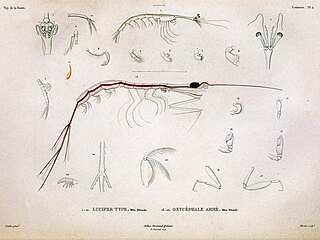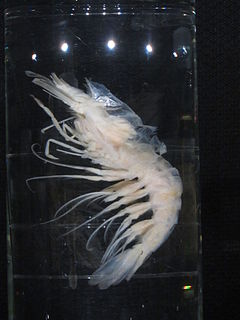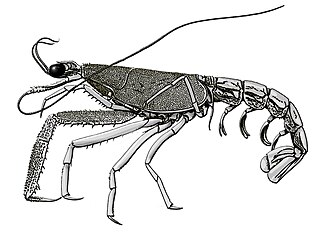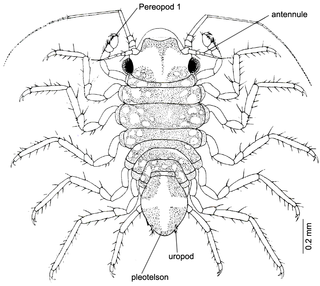
The Caridea, commonly known as caridean shrimp or true shrimp, are an infraorder of shrimp within the order Decapoda. They are found widely around the world in both fresh and salt water.

Dendrobranchiata is a suborder of decapods, commonly known as prawns. There are 540 extant species in seven families, and a fossil record extending back to the Devonian. They differ from related animals, such as Caridea and Stenopodidea, by the branching form of the gills and by the fact that they do not brood their eggs, but release them directly into the water. They may reach a length of over 330 millimetres (13 in) and a mass of 450 grams (1.0 lb), and are widely fished and farmed for human consumption.

The Decapoda or decapods are an order of crustaceans within the class Malacostraca, including many familiar groups, such as crayfish, crabs, lobsters, prawns, and shrimp. Most decapods are scavengers. The order is estimated to contain nearly 15,000 species in around 2,700 genera, with around 3,300 fossil species. Nearly half of these species are crabs, with the shrimp and Anomura including hermit crabs, porcelain crabs, squat lobsters making up the bulk of the remainder. The earliest fossil decapod is the Devonian Palaeopalaemon.

The decapod crustacean, such as a crab, lobster, shrimp or prawn, is made up of 20 body segments grouped into two main body parts: the cephalothorax and the pleon (abdomen). Each segment may possess one pair of appendages, although in various groups these may be reduced or missing. They are, from head to tail:

Lucifer is a little-known and degenerate genus of prawns, the type genus of the family Luciferidae. Lucifer has a long body, but many fewer appendages than other prawns, with only three pairs of pereiopods remaining, all without claws. It also bears no gills. The females, uniquely among prawns, carry the fertilised eggs on her pleopods until they are ready to hatch. This parallels the development of a similar system in pleocyemates, although the attachment is less strong in Lucifer. The length of the eye-stalks and the form of the petasma are used in distinguishing the eight species from each other.

Luciferidae is a family of prawns. These prawns are small, characterised by bioluminescence and the loss or reduction of some appendages. They are predators of tiny planktonic crustaceans for which their third pereiopod is adapted to capture by having thick, curved spines covering the limb. Until recently, the family was thought to be monotypic, but a 2016 cladistic analysis recognized a second genus apart from Lucifer, named Belzebub.

Macrobrachium rosenbergii, also known as the giant river prawn or giant freshwater prawn, is a commercially important species of palaemonid freshwater prawn. It is found throughout the tropical and subtropical areas of the Indo-Pacific region, from India to Southeast Asia and Northern Australia. The giant freshwater prawn has also been introduced to parts of Africa, Thailand, China, Japan, New Zealand, the Americas and the Caribbean. It is one of the biggest freshwater prawns in the world and is widely cultivated in several countries for food. While M. rosenbergii is considered a freshwater species, the larval stage of the animal depends on brackish water. Once the individual shrimp has grown beyond the planktonic stage and becomes a juvenile, it will live entirely in freshwater.

Kiwa is a genus of marine decapods living at deep-sea hydrothermal vents and cold seeps. The animals are commonly referred to as "yeti lobsters" or "yeti crabs", after the legendary yeti, because of their "hairy" or bristly appearance. The genus is placed in its own family, Kiwaidae, in the superfamily Chirostyloidea.

Acetes is a genus of small shrimp that resemble krill, which is native to the western and central Indo-Pacific, the Atlantic coast of the Americas, Pacific coast of South America and inland waters of South America. Although most are from marine or estuarine habitats, the South American A. paraguayensis is a fresh water species. Several of its species are important for the production of shrimp paste in Southeast Asia, including A. japonicus, which is the world's most heavily fished species of wild shrimp or prawn in terms of total tonnage.

Paramysis is a genus of mysid crustaceans (Mysidacea) in family Mysidae, distributed in coastal zone of low boreal East Atlantic Ocean, Mediterranean Sea and the basins of Black Sea, Sea of Azov and Caspian Sea.

Benthesicymus is a genus of prawns, containing the following species:

Crustaceans may pass through a number of larval and immature stages between hatching from their eggs and reaching their adult form. Each of the stages is separated by a moult, in which the hard exoskeleton is shed to allow the animal to grow. The larvae of crustaceans often bear little resemblance to the adult, and there are still cases where it is not known what larvae will grow into what adults. This is especially true of crustaceans which live as benthic adults, more-so than where the larvae are planktonic, and thereby easily caught.

Nototropis falcatus is a species of amphipod crustacean. It is whitish in colour, with brown patches, and grows to a total length of around 7 mm (0.3 in). It lives on soft sediment such as fine sand at depths of 10 to 50 metres, from northern Norway to the west coast of Ireland, including the North Sea, and as far south as the southern Bay of Biscay.

Laurentaeglyphea neocaledonica is a species of glypheoid lobster, and the only species in the genus Laurentaeglyphea. It is known from a single specimen collected on a guyot in the Coral Sea between Australia and New Caledonia. It is thought to be an active predator with colour vision, unlike its nearest living relative, Neoglyphea inopinata.

Marsupenaeus is a monotypic genus of prawn. It contains a single species, Marsupenaeus japonicus, known as the kuruma shrimp, kuruma prawn, or Japanese tiger prawn. It occurs naturally in bays and seas of the Indo-West Pacific, but has also reached the Mediterranean Sea as a Lessepsian migrant. It is one of the largest species of prawns, and is accordingly one of the most economically important species in the family.

Uromunna sheltoni is a species of isopod first described by Brian Kensley in 1977. U. sheltoni is included in the genus Uromunna and family Munnidae. No subspecies are listed. The species was first collected by Peter Shelton of the University of Cape Town, for whom it is named.

Lucensosergia lucens is a species of shrimp popularly known as the sakura shrimp or sakura ebi. The translucent pink shrimp derives its name from sakura, the Japanese word for the cherry blossom. The species grows to about 4–5 cm and lives primarily in Suruga Bay in Shizuoka Prefecture, Japan, where it is caught to be eaten. It is also caught in Taiwan.

Kraussillichirus kraussi, commonly named the common sandprawn or pink prawn, is a species of ghost shrimp, an African crustacean in the family Callianassidae.

Penaeus semisulcatus, the green tiger prawn or grooved tiger prawn, is a commercially important species of prawn in the genus Penaeus.

Belzebub hanseni, the ghost shrimp or ghost prawn, is a small planktonic and benthic species of prawn from the family Luciferidae.



















